Viola rotundifolia Michx.
Kim’s notes, re-ordered but unedited. Illustrations: 6 photographs of Viola rotunda and 1 drawing.
2n=2x=12 (a diploid species).
Andre Michaux, 1746-1802.
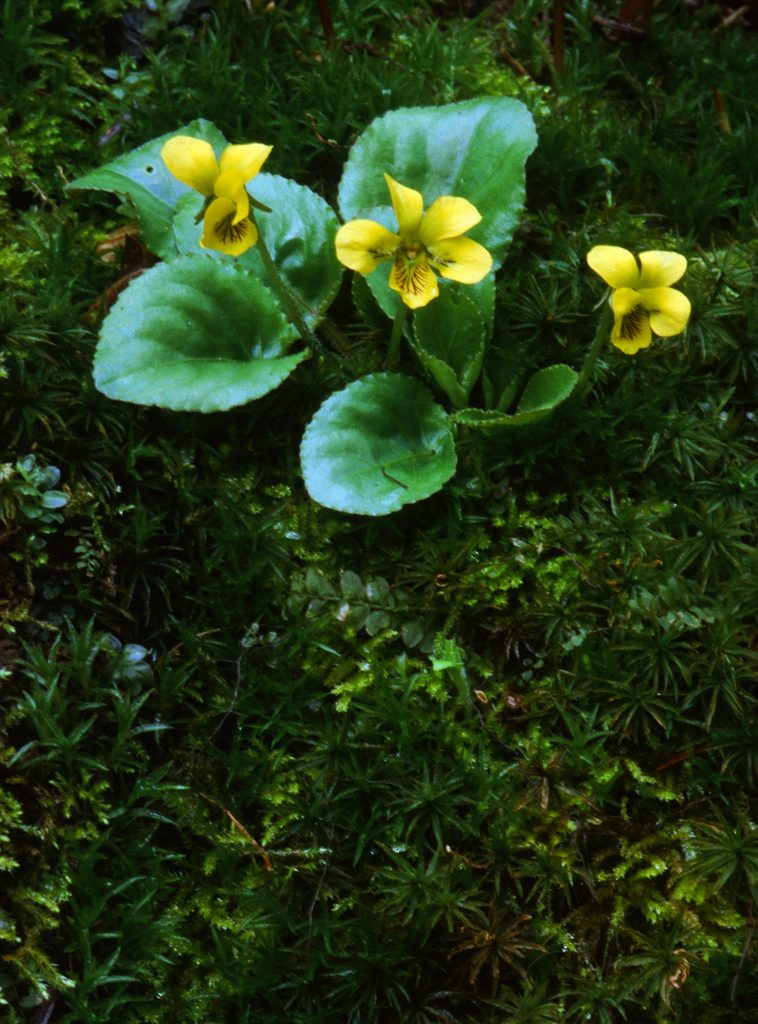
(From Kim’s article for NARGS):
Viola rotundifolia is the only yellow flowered viola in North America that is stemless at the time of flowering. It is also the earliest viola to flower [correction: V. hastata is earlier by about one week, though they are often both seen out at the same time] and may be finished by the time the other violas flower. Its ovate spring leaves appear dark green and fleshy, with wavy, obviously toothed margins.
Viola rotundifolia is stemless at the time of chasmogamous flowering. The flower peduncles arise from the crown of the rhizome. Later in the season the plant produces stems from the crown that grow our horizontally usually underneath the leaf litter. Because they are hidden thus, they are not usually observed unless the leaf litter is removed. In the grounds of Canaan Valley Resort, West Virginia, in mid-June I photographed the stems of Viola rotundifolia producing cleistogamous buds. The stems are up to 5 cms long. At the end of the stem cleistogamous flower pods are produced on short lateral peduncles from the axil of a bract. There can be up to three pods on each stem, each borne on a separate peduncle and each from a bract of the upper stem. There are no bracts or peduncles produced on the base of the stem. Also good illustration of this in Viola Brainerd Baird’s book, p. 168.

Round-leaved Yellow Violet (Viola rotundifolia Michx.)
Identification: Leaves basal and flowers on separate stalks. Flowers yellow. Leaves heart-shaped and small in a basal cluster.
Distribution: Ohio in the east to southeastern Canada in the east, southward to Georgia and Tennessee in the mountains.
Habitat: Round-leaved Yellow Violet is found in wet forest.
Flowering period: April to May.
Similar Species: Round-leaved Yellow Violet is the only yellow violet in eastern North America with basal leaves and flowers on separate stalks.
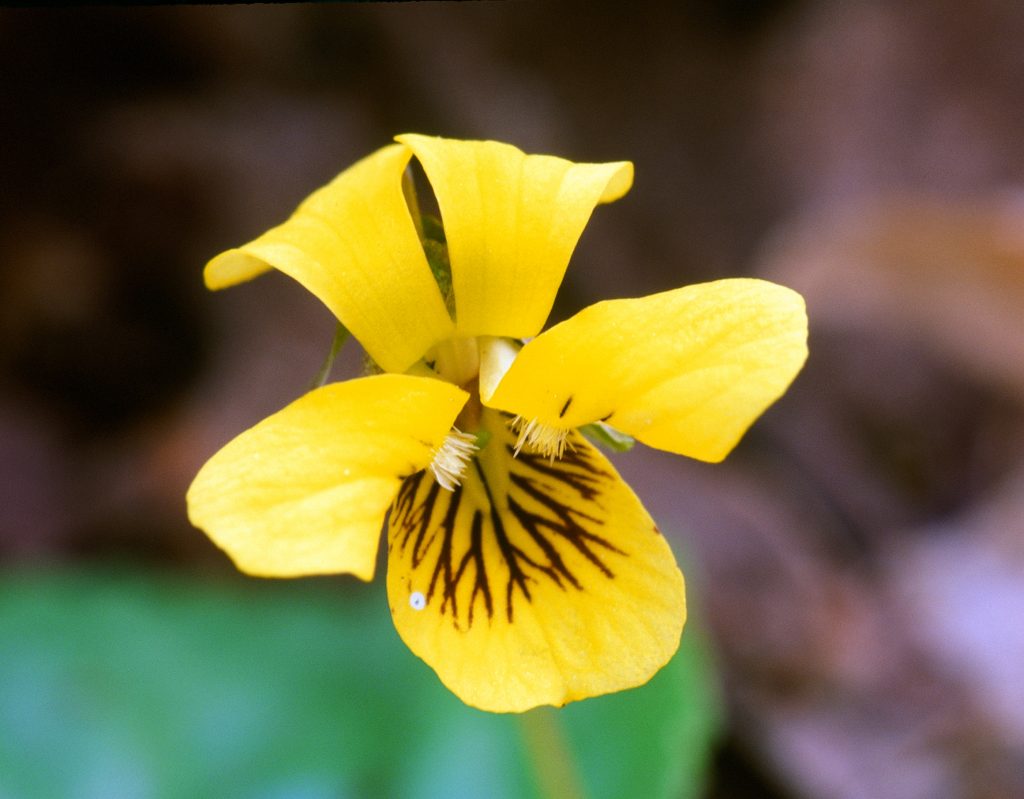

TM: Sect. Chamaemelanium subsect. Rotundifoliae [New classification, 2010]. In V. guadalupensis paper he says subsection Orbiculares??
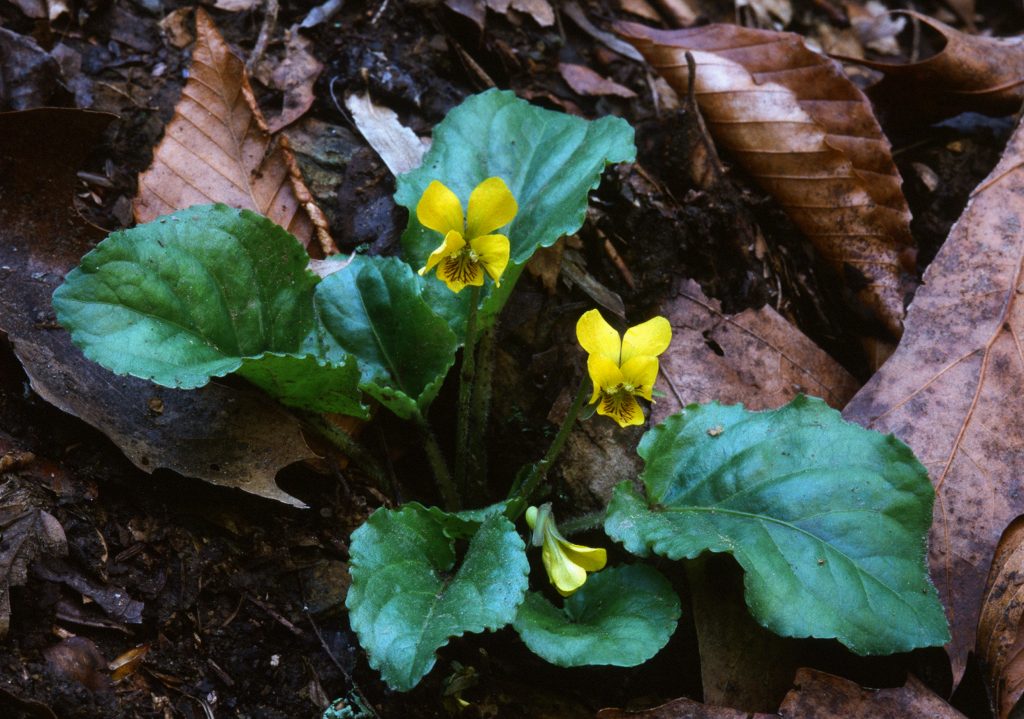
Barry Glick’s catalogue: The earliest Viola to bloom in the spring is Viola rotundifolia. V. rotundifolia springs forth from a rather rough rootstock that becomes horizontal as the plant ages. The Spring leaves are orbicular or ovate and are mildly pubescent with short white hairs. The flower petals are bright primrose yellow with three lower brown striations, sometimes chocolate tinted. The summer leaves are almost orbicular, but cordate at the base. It is the only stemless yellow violet found in West Virginia. When I say stemless, I am referring to the plant not the flowers.
From Benton’s Hollow, seeds very pale cream to white, 1.9 x 1.1 mm, p. 11.
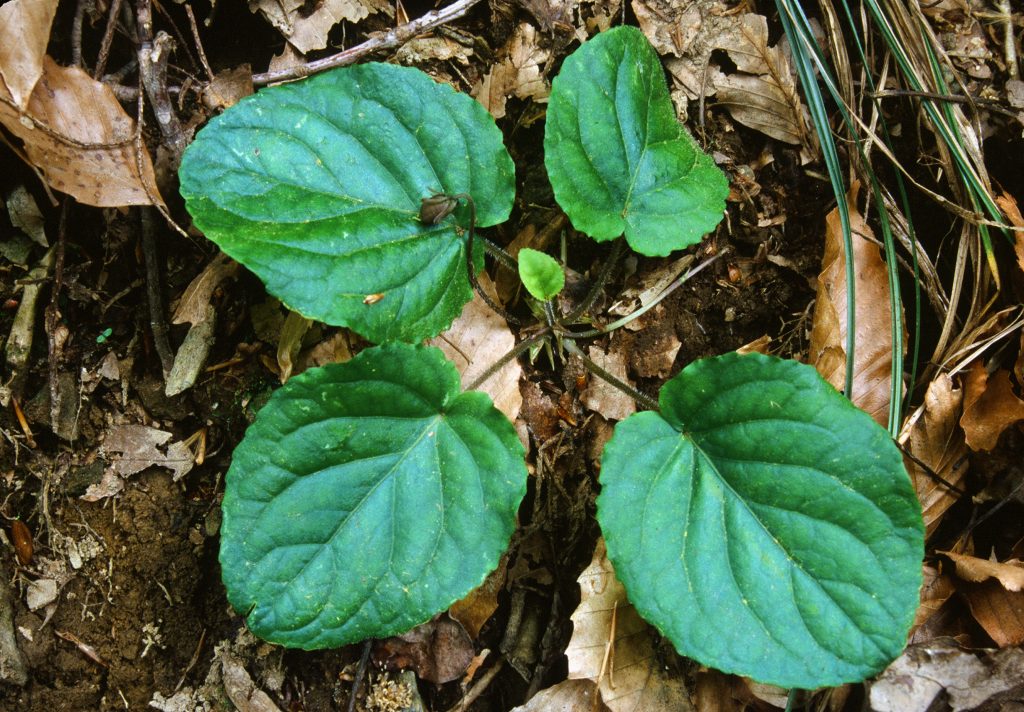
Ferncliff Wildflower Preserve, formerly Benton Hollow walk with Tim Draude (1999): Fine soil made from erosion of fine particle silt from schist. pH almost neutral, because of high chloride content of Wissahickon schist. On road bank with not as much leaf litter. This is the only site for V. rotundifolia in Lancaster County but it is found more frequently further west in the state. V. rotundifolia is growing in full shade, wet, acid spring seeps with hemlocks, tulip trees (Liriodendron tulipifera), oaks, rhododendrons near a stream. V. rotundiflora has a very short flowering season, only open for 1-2 weeks, all flowers open at the same time. 17 April, 1999 (which was a year with an early spring). Cleistogenes are produced on horizontal stems growing on surface of the soil usually under leaves, and therefore not easily seen. It is usually described as ‘stemless’ and is at flowering time, but is actually a stemmed species. Summer leaves are huge, not looking like a violet leaf at all, more similar to Bergenia cordifolia.
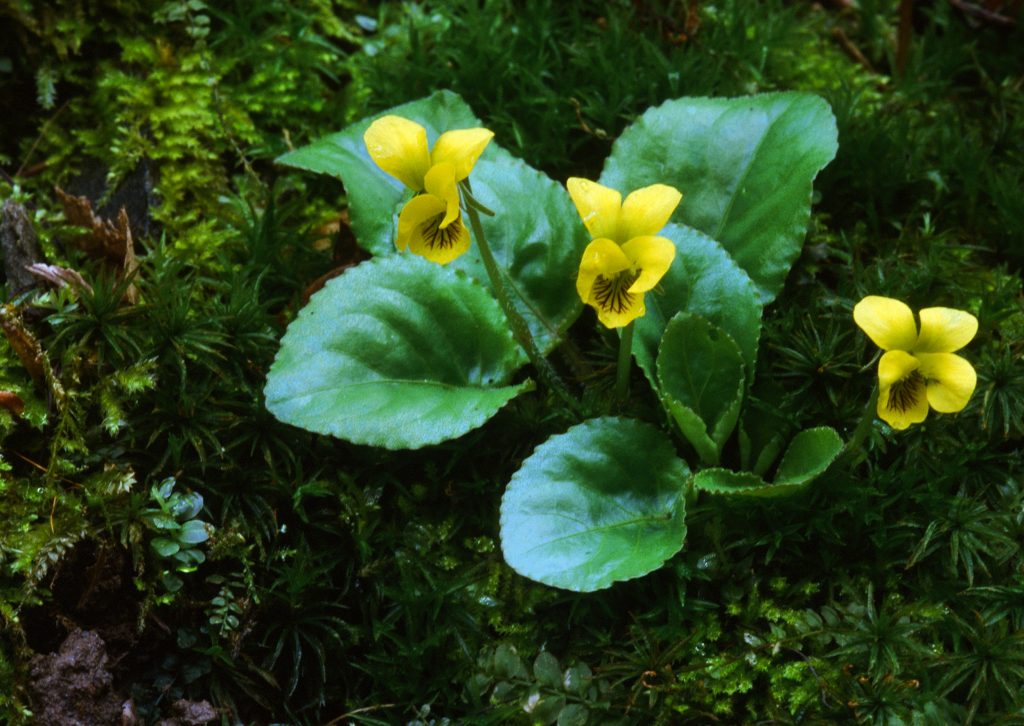
In Maine, Grace F. Babb wrote for the Am. Rock Garden Soc. bulletin, 1946, that this rather fussy treasure grows in sandy acid soil.
Viola rotundifolia flowers when Trillium erectum is at its’s peak at Shenks Ferry, PA, 2-3 weeks before V. striata.
Perfume of flowers not obvious in very cold weather, when insects will not be out.
In Ohiopyle S.P. V. hastata was always growing with Viola rotundifolia on acid soil. V. hastata flowers about a week earlier than V. rotundifolia. These two species were growing together in the Great Smoky Mountains with Kalmia latifolia [=acid]. Also growing together on Canaan Valley resort trail below the lodge, an area of acid soil. Here there was evidence that the two species were hybridizing as some of the plants of V. rotundifolia had slightly variegated leaves.
Growing together in the Dunbar Valley (4/14/05) were VV. hastata, eriocarpa (basic), rotundifolia, sororia, rostrata (very acid) and blanda (acid). They did not grow where they was Dicentra cucullaria (Dutchman’s breeches (alkaline). V. hastata flowers earlier than VV. blanda, rotundifolia, and slightly ahead of V. rostrata, with purple persistent (evergreen) leaves from the previous season, basal leaves, new season shoots of verical stems, also Trillium erectum, Sanguinaria canadensis and Claytonia virginica (Spring Beauty). At the Dunbar valley site of the walk up from the Rifle Target Range there are alternating bands of soil of different pH, some very acid where V. rotundifolia, V. hastata and V. rostrata grow, and some alkaline where V. eriocarpa/scabriuscula grows with Dicentra cucullaria.
V. hastata and V. rotundifolia also both growing together in Canaan Valley resort walk down through the trees on slope facing SE. There were some plants of V. rotundifolia there with lightly variegated leaves, ie leaves were not strongly two toned, but there was a slight variegation, noted at first by Mike Slater.
Found growing under hemlocks in NY state, on Van Hornsville School Nature Trail, Herkimer Co. This was an area exclusively of limestone, some tufa rocks, large tufa walls with caves and shale. The plants growing in the area were V. sororia, V. eriocarpa (scabriuscula), V. adunca minor, Trillium erectum (red), Dentaria laciniata, Erythronium americanum , Geranium maculatum, Skunk cabbage (Symplocarpus foetidus), Dicentra canadensis and D. cucullaria, Uvularia, Asarum canadensis, Blue Cohosh (Caulophyllum thalictroides), American Beech Trees, Hickory trees, and dominantly Hemlocks (Tsuga). Same combination of Erythronium americanum, hemlocks, and V. rotundifolia at Benton Hollow, and Ricketts Glen S.P. (PA) with Trillium luteum, all places where Viola blanda (incognita) grows. At Dunbar Creek, also Trillium erectum, Dicentra canadensis and D. cucullaria, V. eriocarpa, V. sororia and V. blanda. Also beside Susquehanna River, park visited with Nick and Morris and MDNARGS group, Erythronium americanum, Blue Cohosh (Caulophyllum thalictroides), Dentaria laciniata and Viola sororia. Shenk’s Ferry has Dicentra canadensis and D. cucullaria, V. eriocarpa, Geranium maculatum, Erythronium americanum, V. sororia, V. striata. Great Smoky Mountains climb up on long walk came to an area of Geranium maculatum, Trillium luteum and V. blanda. Are all these areas underlain with limestone? V. rotundifolia (Early Yellow violet) often grows with Viola hastata which usually comes out a little later, for example in the Great Smoky Mountains, and in the grounds of Canaan Valley Hotel there was a hybrid, looking like V. rotundifolia but with lightly variegated leaves.
See Viola Brainerd Baird’s book p. 166-8: The Eastern Round-Leaved Yellow Violet has the distinction of being our only Stemless Yellow Violet, but only in its spring flowering stage is this strictly true. The flowers and leaves arise from a stout scaly rootstock which is covered with the remains of old petioles and has long stout roots. The plants are sparingly pubescent with short stiff hairs on the upper surface of he leaves, especially on the outer margins. The early leaves are on short pubescent petioles and are about one inch wide. They are dark bluish green and of glistening silk-like texture. They are oval to round, the base is heart-shaped with a narrow opening, the margin is wavy and scalloped (crenate), the tip is obtuse. The peduncles of the flowers little exceed the leaves. The petals are deep lemon-yellow, the three lower are veined with brownish purple, the two lateral are bearded. The capsule is oval, closely dotted with purple, and the seeds are nearly white, or the color of old ivory. The pistil of this violet is much like that in the stemless blue, white and lavender groups, where the summit of he style is flattened and margined. In this violet, however, the stigmatic aperture is in the style summit, as the aperture tube is lacking or inconspicuous. [There are no hairs on the head of the style!] After the open flowers are through blooming, an inclined, dark purplish stem is sent up from the rootstock, which becomes three to six inches long. It has tiny bracts in place of leaves, and in their axils the closed flowers are borne on short peduncles. The dark purplish stems perplexed the early botanists, who regarded these later plants as a distinct species. It blooms in May, and is found in cool, rich woods. It extends from Maine westward to Ontario and southward through New York, New England and along the Appalachian Mountains to northern Georgia. It is somewhat akin to a northwestern violet, V. orbiculata. This is shown by the yellow flowers, the round leaves, and the similar habitat. The closed flowers in the western species are borne on stems which have small reduced leaves, instead of tiny bracts as in V. rotundifolia. However, the pistils of these two violet are quite unlike, and partly for this reason botanists place them in different sections. [I wonder if this species has arisen from hybridization with a stemless blue species??? because of the shape of the style and stigma (pistil) which could also be the reason for the reduced stems. Genetic analysis of this species will be interesting when compared with other yellow violets and the stemless species of Eastern north America.]
- 217: Viola rotundifolia Michx., Fl. Bor. Am. 2: 150, 1803. Type: high mountains of the Carolinas, perhaps by Michaux himself. Colour plate in Viola Brainerd Baird’s book from plants collected by Ezra Brainerd, at the base of the Green Mountains, near Salisbury, Vermont, May 15, 1908. Line drawing of mature plant: partly after a drawing in Vt. Agr. Exp. Bull., 224, P. 94, 1921, and partly from plants collected by the author in the Green Mountains east of Middlebury, Vt., July 28, 1940.
2n=2x=12
Great Spangled Fritillary Speyeria cybele: Life Cycle Tiny caterpillar overwinters after hatching from pale brown egg. Caterpillar black with branching spines that are orange at base; feeds on violets (Viola rotundifolia). Chrysalis mottled dark brown.